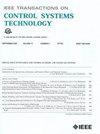人类驾驶员的导向控制:控制设计与实验
IF 3.9
2区 计算机科学
Q1 AUTOMATION & CONTROL SYSTEMS
引用次数: 0
摘要
本文研究了当自动驾驶车辆不仅响应参考速度,而且还考虑到后续人类驾驶车辆(HV)的速度时,人类驾驶员通过自动引导车辆的引导。为了验证理论结果,开发了人在环(HITL)仿真环境,其中图形界面显示前方自动车辆,而人类操作员通过油门和刹车踏板控制后面车辆的速度。9名人类驾驶员参与了实验,每人完成了79种自动驾驶车辆控制增益组合的驾驶任务。基于实测数据,采用扫描最小二乘法估计人类驾驶员模型参数;实测结果证实了理论模型在设计高级交通控制策略中的适用性。本文章由计算机程序翻译,如有差异,请以英文原文为准。
Guided Control of Human Drivers: Control Design and Experiments
This brief investigates the guidance of a human driver via an automated lead vehicle, when the automated vehicle is not only responding to a reference velocity but it also takes into account the speed of the subsequent human-driven vehicle (HV). To verify the theoretical results, a human-in-the-loop (HITL) simulation environment is developed, in which a graphical interface illustrates the automated vehicle ahead, while the human operator controls the velocity of the following vehicle via the accelerator and brake pedals. Nine human drivers were involved in the experiments, each of them carried out the driving task for 79 control gain combinations of the automated vehicle. Based on the measurement data, the parameters of the human driver model were estimated using the sweeping least squares method; the measurement results confirmed the applicability of the theoretical model in designing advanced traffic control strategies.
求助全文
通过发布文献求助,成功后即可免费获取论文全文。
去求助
来源期刊

IEEE Transactions on Control Systems Technology
工程技术-工程:电子与电气
CiteScore
10.70
自引率
2.10%
发文量
218
审稿时长
6.7 months
期刊介绍:
The IEEE Transactions on Control Systems Technology publishes high quality technical papers on technological advances in control engineering. The word technology is from the Greek technologia. The modern meaning is a scientific method to achieve a practical purpose. Control Systems Technology includes all aspects of control engineering needed to implement practical control systems, from analysis and design, through simulation and hardware. A primary purpose of the IEEE Transactions on Control Systems Technology is to have an archival publication which will bridge the gap between theory and practice. Papers are published in the IEEE Transactions on Control System Technology which disclose significant new knowledge, exploratory developments, or practical applications in all aspects of technology needed to implement control systems, from analysis and design through simulation, and hardware.
 求助内容:
求助内容: 应助结果提醒方式:
应助结果提醒方式:


